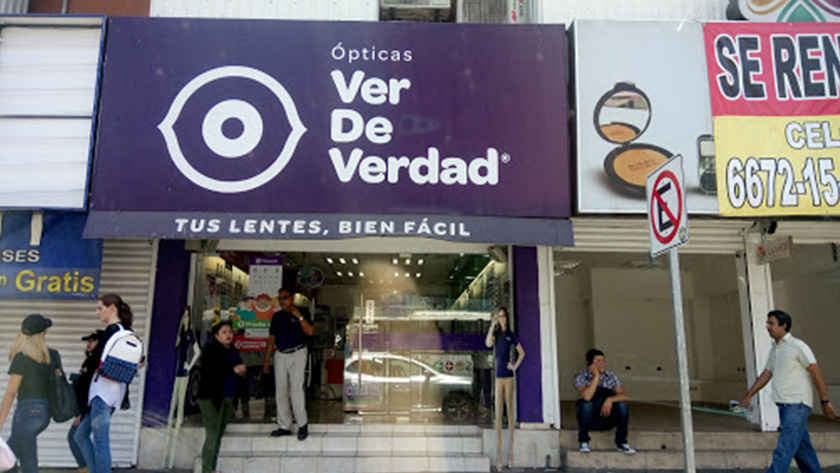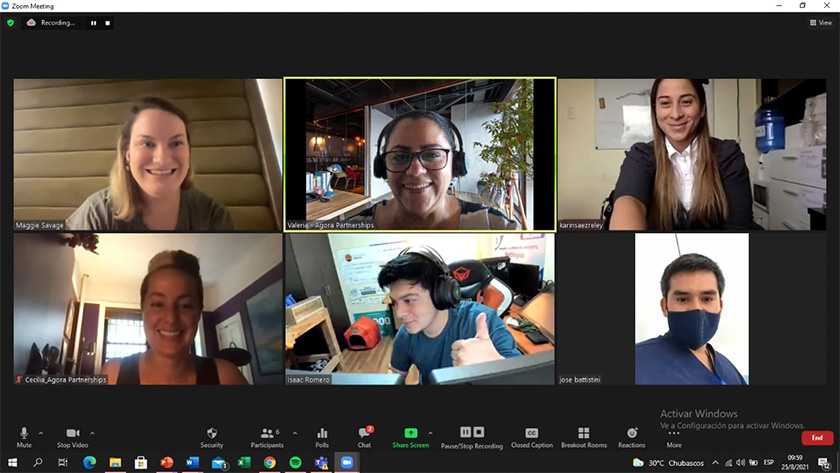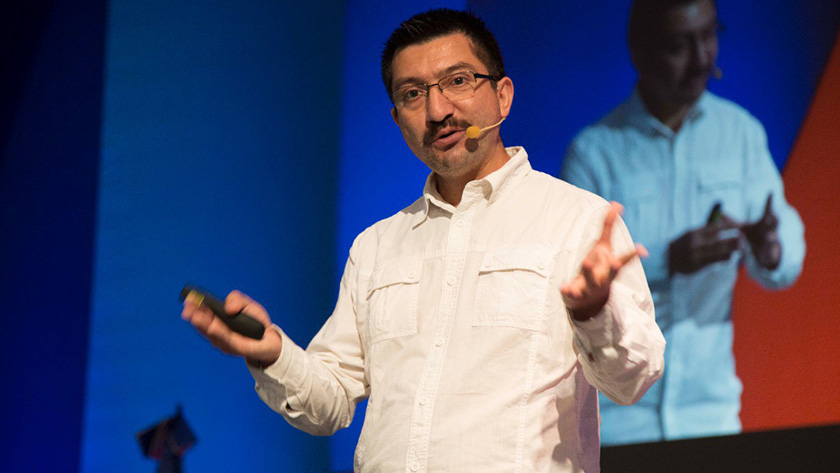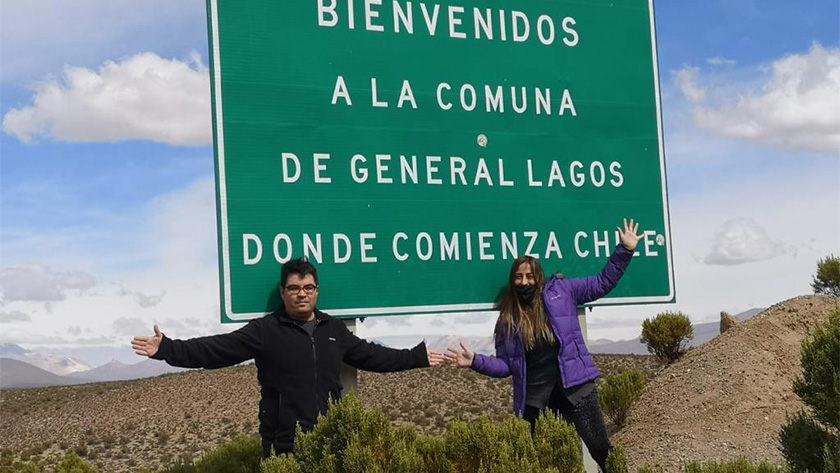Scaling a solution is not the same as solving a problem at scale. Nearly 1 billion people around the world live with blindness or vision impairment that is correctable with a pair of eyeglasses. No single solution will ever scale to solve a problem of that enormity.
EYElliance set out to solve this billion-person problem not by scaling a single solution but with a system orchestration approach—when social innovators fuel change behind the scenes by connecting people, providing resources and support, and mobilizing collective, unified efforts. EYElliance is agnostic to the solution. Its goal is to solve this very solvable problem at a population level with an ever-expanding toolbox of solutions in a variety of contexts.
We’ve already looked at EYElliance’s work in Liberia, where they collaborated with the Liberian Ministries of Health and Education, NGOs, and the private sector, all of whom came together to transform the eye health landscape and spur exponential change in a system that was previously marked by incremental growth. Now we’ll turn to a part of their work that falls into the “proactive” model of impact, where an intervention accelerates the rate of change in a system that has shown indicators of movement in a positive direction.
“One of EYElliance’s founding premises is that inclusive optical can become a new impact industry, one on a similar scale to off grid solar. We started to see profitable inclusive optical businesses meeting the needs of low- and middle- income consumers popping up in a couple of countries and we asked ourselves how could EYElliance fan the flames of what was already working.” –Elizabeth Smith, co-Founder of EYElliance
Smith and EYElliance co-Founder, Jordan Kassalow, understood that development finance plays a critical role in the growth of any impact industry, so they decided to test an approach to attract new, innovative development investment in Latin America and beyond.
Vision correction feeds into several Sustainable Development Goals: eliminating poverty (SDG 1), ensuring good health and well-being (SDG 3), providing quality education (SDG 4), advancing gender equality (SDG 5), and guaranteeing decent work (SDG 8), and the UN General Assembly recently passed a resolution calling for universal access to eye health for all by 2030. Eyeglasses fundamentally change lives for the better, making eye health an attractive investment for development finance institutions.
“There is such great evidence in terms of how vision translates into pro-development metrics: kids learning better, adults becoming more productive, and road traffic accidents decreasing,” said Kassalow. “It became a natural issue area that fit very well into the mandate of development finance.”
Investment from development finance is rarely deployed in tranches less than $10 million. Accordingly, EYElliance is exploring how developing a critical mass of inclusive optical companies could attract regional investment in Latin America. To do so, EYElliance engaged a select cohort of entrepreneurs to launch and scale regional chains of inclusive optical stores, helping them adapt a successful model—Ver De Verdad, a 100-location chain in Mexico—for markets in Chile, Peru, and Ecuador.

Recognizing how investment from development finance can signal impact potential and catalyze further private sector investment, EYElliance has been in conversation with the US Development Finance Corporation (DFC) about their work to accelerate scale out of a profitable inclusive optical business models. “This is just up our alley,” said James Polan, Vice-President, Office of Development Credit, DFC, “particularly with regard to curation and training.”
Through a process of exploratory landscaping, Smith and Kassalow met with Hugo Moreno, a Mexican entrepreneur who had successfully scaled a single optical shop to a chain of 100 locations in just seven years. Ver De Verdad offers affordable, high-quality eyeglasses with tiered pricing appropriate for low income and emerging middle-class customers. More than half of the customers of Ver De Verdad were first-time wearers of eyeglasses—Moreno was expanding the market in urban areas and aspired to secure investment to open an additional 200 stores.
In Ver De Verdad, Smith and Kassalow saw a replicable model that was robust, profitable, proven to deliver significant social impact, and with capacity for scale.
“When someone comes to one of our stores, it is about helping them, not just about selling to them. We must first get people an eye exam and see if glasses will help improve their quality of life. Then we need to convince them to invest in a pair of glasses.” -Hugo Moreno, CEO of Opticas Ver de Verdad
While attending a Skoll World Forum shortly after, Smith and Kassalow met with Miller Center for Social Entrepreneurship and learned of its Replication and Scaling Initiative designed to help social enterprises learn from established models. With its Scale-Out Master Class framework and coaching capacity, Miller Center began working with EYElliance and Ver De Verdad to create a 12-module playbook to capture the key, non-confidential elements of the Ver de Verdad model to transfer that knowledge in a structured three-month course to entrepreneurs looking to scale into new optical markets.
The Ver De Verdad optical playbook designed by Miller Center supports new or early-stage optical enterprises to launch and grow their business faster and more successfully by learning best practices from Moreno’s direct experiences. The playbook proved to be such an adept distillation of the Ver De Verdad business model that Moreno now uses it as an internal training tool as part of onboarding new staff. During the three-month bootcamp, these entrepreneurs covered a complete range of modular content, from market research techniques to business plan creation:
Miller Center’s analysis of the data on scaling shows that one of the biggest causes of failure in scaling is failure to identify what parts of the business model must remain constant and what parts can adapt to the new market and competitive environment. “People eat chicken soup all over the world, but with all kinds of variations,” said Rob Shelton, Executive Fellow—Scaling and Replication at Miller Center. “In our scaling recipe, some ingredients are critical for success, but some can be altered to adapt to different palates. These entrepreneurs understood the core of Ver De Verdad’s model and how it fit into their local context.”
Shelton and Miller Center have worked with over 60 entrepreneurs using this playbook approach on a range of enterprises, including last mile distribution and mini-grids, with some seeing a six-fold increase in their impact in the first 18 months.
“The essence of the playbook was distilling down all of those different things that Ver De Verdad tried and tested over their first few years that resulted in a solid model,” said Maggie Savage, Global Director for Private Sector Scale at EYElliance. “What Miller Center does really well is differentiate what needs to be replicated religiously from what’s adaptable. This helped put the cohort of entrepreneurs far ahead of the curve.”
System orchestrators are particularly adept at recognizing gaps and bringing in partners with complementary expertise. EYElliance itself lacked the capacity and network to source a set of promising entrepreneurs in Latin America, so it brought in the team at Agora Partnerships to assist. Agora Partnerships sourced over a hundred leads and alongside EYElliance and Miller Center selected a group of 25 entrepreneurs from nine countries in Latin America to submit formal applications.
Each of these entrepreneurs had established successful businesses with social impact at their core. After a final round of screening and interviews, the cohort was comprised of four entrepreneurs: América Silva Falcón, Founder, TakeAHand (Chile), Williams Isaac Romero Martínez, Founder, BOTTLEEYES (Ecuador), José Battistini Salcedo, Founder, Luz De Vida (Peru), and Karin Saez, Founder, RetiDiag; Founder, Rooget (Chile).
“These entrepreneurs understood the idea of this profound unmet need in their communities for affordable vision services. They all had a balance of business acumen, but also the heart of a social entrepreneur.” -Jordan Kassalow, EYElliance co-Founder
Karin Saez founded RetiDiag, a Chilean company that optimized the process of timely detection of patients with diabetic retinopathy using new software and methodology, therefore reaching more patients at lower cost. She found great value in the wealth of practical tips the playbook provided. “The perspectives are very tangible,” said Saez. “It took all the theory and gave us real insights for when the rubber hits the road. We learned from Hugo’s successes, mistakes, and from his decision-making process that made it possible to build up a hundred branch company.”

Saez and her co-Founder, Juan Contreras, of Rooget, their nascent inclusive optical venture, found particularly valuable the insights of how to project their financials and how to tailor their approach for sourcing investment to specific audiences. “We learned what different types of investors expect and it’s not always the same story you tell—we must be able to translate our message and adjust the format based on the audience,” said Contreras. “The language and framing are different if it’s public investment money from the government in the earliest stage or private sector investment at a later stage.”

On the strength of the playbook and ongoing technical support from EYElliance, Agora Partnerships, and Miller Center, Rooget feels equipped to enter the market. “We have the team, the passion, the skills, and we learned so much from the whole program,” said Saez. “The next step is to raise money to create a runway long enough to start our first two stores. We’ll learn from there, implement our marketing strategies and our entire roadmap.”
For Saez and the other entrepreneurs in the cohort, the mentoring and technical assistance from EYElliance, Miller Center, and Agora Partnerships is ongoing. Most recently, this mentorship has focused on working to refine the financial models and the funding asks of each enterprise. “We have established a close working relationship, essentially as business coaches,” said Shelton. “They are strong and confident and continue to reach out to us for guidance, get input to their plans, and to help them address their challenges and opportunities.”

Individually, Saez and her cohort of inclusive optical entrepreneurs fall into the “missing middle” of capital needs, says Savage. “They’re too big for anything that’s microfinance or friends and family rounds, but they’re too early stage for traditional banks and lenders,” she said. “Because of the nature of the model, they’ll need a sizable influx of new capital to scale pretty quickly. There’s an opportunity here for innovative financing and to explore different types of financial vehicles to support their growth.”
With its vision of the burgeoning inclusive optical sector transformed into a new impact industry, EYElliance began by testing a working assumption: the creation of regional investable optical sectors could attract development finance and a deeper pool of capital. This initial approach required EYElliance to orchestrate a web of partners that collectively support the proliferation of a successful business models in new markets. Crucial indicators of success will be sustained new investment into the space and ultimately, a competitive landscape will mark a transformed system—other entrepreneurs recognizing the market and impact potential of inclusive optical.
“The businesses opportunity of inclusive optical is increasingly being recognized,” said Kassalow. “This has been made evident by new businesses entering the market on their own, and EYElliance aims to accelerate the inevitable. This is our first step in our journey to see how we can be most useful in bringing in investment to support private sector eye health solutions globally.”
Want more stories of transformational change on the world’s most pressing problems? Sign up for Skoll Foundation’s monthly newsletter.